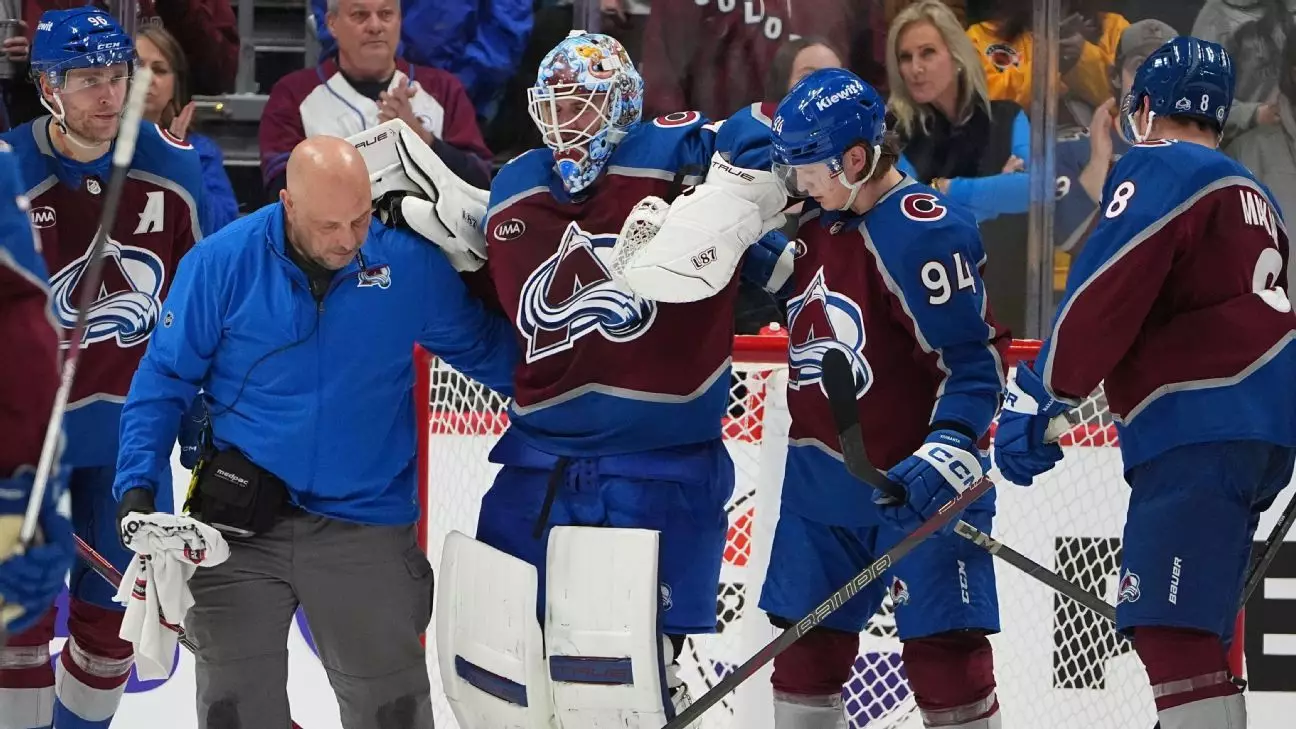In an electrifying night in Denver, the Colorado Avalanche secured a paramount victory against the Buffalo Sabres, overcoming a three-goal deficit to win 6-5 in overtime. Despite such an inspiring comeback, Avalanche coach Jared Bednar found himself consumed by frustration stemming from a critical decision—or lack thereof—made by the referees during a pivotal moment in the third period. The incident raises essential questions regarding player safety in ice hockey and how officiating affects the dynamic and integrity of the game.
The drama unfolded when Avalanche goaltender Scott Wedgewood found himself in a precarious situation as Sabres forward Zach Benson crashed into him after being bumped by a teammate. Wedgewood remained on the ice, visibly hurt, while the play continued, ultimately leading to a goal that further exacerbated the Avalanche’s woes. The moment was deeply troubling for Bednar, who felt it was a clear-cut case for stopping the game in the interest of player safety. “If he’s hurt and he’s not getting up… the whistle should go,” Bednar stated firmly, emphasizing that the officials were in close proximity and should have taken the necessary precautions.
His reaction is understandable; after all, goaltenders are integral to the game, and their safety is imperative. The lack of a whistle not only jeopardizes the stamina and well-being of the player involved but also contravenes the principles of fair play. In elite sports where athletes operate at high speeds and take risks, administrative failures can lead to serious injuries, and that should always raise a red flag.
No one doubts the pressure referees face while officiating an NHL game. With the stakes high and the adrenaline flowing, it’s easy to understand how the fast pace of the game might lead to oversights. However, as Bednar pointed out, this incident also touches upon a deeper flaw in officiating: consistency. Referees often stop plays in cases of potential injury to regular players, so why not extend that same consideration to goaltenders, who are equally vulnerable when their position is compromised?
“The rule would state that we have to touch it,” Bednar remarked, underscoring the inconsistency between what is theoretically mandated and what happens in practice. If the NHL is serious about injury prevention and the welfare of its players, stricter adherence to established rules must follow. The league should ideally educate its referees on the nuances of player safety, ensuring sensitivity not only to the immediate events but the long-term repercussions of poor decisions.
A bitter sense of injustice was palpable within the Avalanche camp, but rather than allowing frustration to derail their performance, the team channeled that energy. It resulted in Jonathan Drouin tying the game in the final moments of regulation and Devon Toews netting the decisive goal in overtime. The unexpected turn of events showcased resilience and determination—qualities critical in sports but often overstated in the face of adversity. Teammates echoed the sentiment in the aftermath, focusing on supporting Wedgewood, who would ultimately be sidelined for an unspecified period due to the injury.
While the victory was undoubtedly sweet, it must serve as a reminder of the fragile balance between competition and safety. Players like Toews recognized the incident as a rallying point. “That fired us up,” he noted, emphasizing that in adversity lay the seeds for a renewed sense of purpose.
Coach Bednar mentioned his intention to reach out to the NHL regarding the officiating, signaling a need for accountability within the league. This instance should be a wake-up call not just for the referees but for everyone involved in the NHL. Open dialogues about player safety and officiating standards can lead to meaningful changes that benefit athletes across the league.
This encounter on ice underlined that hockey is not merely a series of goals and victories but also a manifestation of ethical considerations surrounding safety and fairness. As the sport evolves, so too must the approach to officiating, ensuring that the rules reflect the changing dynamics of player welfare. For the players and coaches alike, it’s crucial to turn the anger and frustration into a force for improvement—both on and off the ice.

